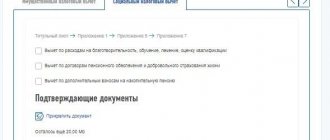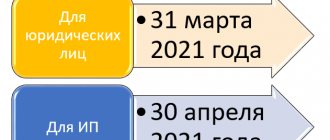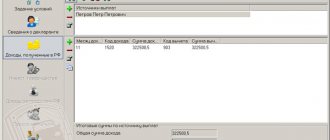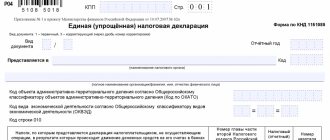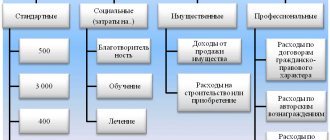The Tax Code provides for individual entrepreneurs and organizations the opportunity to replace tax returns for different taxes with one single simplified declaration.
To do this, the following conditions must be met:
- The taxpayer must not have any transactions that result in the movement of funds in bank accounts (at the cash desk).
- The declaration can be submitted only for those taxes for which there are no objects of taxation (income, sales of goods and services, property, etc.).
In essence, the fulfillment of the above conditions means that the actual activity is not carried out
or the taxpayer has only recently registered and is just starting his activities.
Deadlines for filing tax returns
A single simplified declaration is submitted no later than the 20th day of the month following the expired quarter, half-year, 9 months or calendar year.
Moreover, if filing a declaration for a specific tax is provided only at the end of the calendar year (for example, for payers of the simplified tax system), then a single declaration does not need to be submitted quarterly.
The declaration based on the results of 2021 must be submitted by January 20, 2021 inclusive.
Penalties for late submission of the declaration:
Currently, there is a dual position of the financial department on the issue of holding people accountable for late submission of a simplified declaration.
According to the first position, liability arises under Art. 119 of the Tax Code of the Russian Federation in the form of a fine in the amount of 1,000 rubles. In this case, the fine is issued not for the declaration itself, but for each tax that is indicated in it. Thus, if the simplified declaration reflects 2 taxes, the fine will have to be paid in double amount.
note
that the provisions of this article in the form of a fine in the amount of 5% of the amount reflected in the reporting do not apply to the simplified declaration, since it does not contain data on income received and taxes paid.
According to the second position, supported by Letter of the Ministry of Finance of the Russian Federation dated July 3, 2008 N 03-02-07/2-118, for late submission of a simplified declaration, an organization or individual entrepreneur can only be prosecuted under Article 126 of the Tax Code of the Russian Federation, in the form of a fine in the amount of 200 rubles . for the declaration (not the tax!).
note
, if the taxpayer did not have the right to submit a single return, but filed it anyway, then he faces a fine for failure to submit returns for all taxes for which he was required to report.
Conditions for filing a declaration
The right to file a single simplified declaration is provided for in Article 23 and Article 80 of the Tax Code. This form is submitted by payers of one or more taxes who, in the reporting period:
- There were no objects of taxation.
- There was no movement on current accounts and cash registers.
Attention! Any movement of funds through a current account or cash desk, including erroneous crediting or debiting of money, will become an obstacle to filing a single simplified declaration. This also includes the fee for maintaining a bank account. In general, any operation, be it incoming or outgoing , automatically means that the subject will not be able to submit the declaration in question. The amount of such an operation does not matter - the fact of its existence is important.
It is necessary to distinguish a single simplified declaration from a tax return in connection with the use of a simplified taxation system. Apart from the name, there is nothing similar between them.
Who cannot submit a single declaration
The above conditions are necessary, but not sufficient for filing a single simplified declaration. Besides them, there are others.
In particular, the ability to file this declaration depends on the tax regime . So, if a company or entrepreneur uses UTII , then such a declaration cannot be submitted, because this system cannot have “zero” reporting.
Entrepreneurs using the general taxation system will also not be able to file the declaration in question. The fact is that they pay personal income tax on their income and must report on it, regardless of their availability.
In addition, the declaration cannot replace reporting on the following taxes:
- MET;
- excise taxes;
- gambling tax.
This is due to the fact that reports for these taxes are provided monthly, and a single return can only be filed for taxes that must be filed quarterly or annually.
Who is eligible to submit the form?
If we take into account all the above exceptions, then the list of taxes that, in the absence of activity can be included in a single simplified declaration will be as follows:
- income tax;
- corporate property tax;
- transport tax;
- land tax;
- VAT;
- water tax;
- tax under the simplified tax system.
- tax under the Unified Agricultural Tax.
However, the fact that the above taxes are included in a single declaration does not mean that the entity must report on all of them. If he is not, for example, a payer of water tax or land tax, there is no need to indicate the relevant information in a single declaration. In other words, the declaration is completed in relation to those taxes for which the submitting entity is the payer.
As for the last two taxes on the list, the advisability of filing a single declaration in respect of them is questionable. It’s easier and more reliable to submit a zero declaration under the simplified tax system or unified agricultural tax - then the inspectorate will definitely not have any questions for the taxpayer.
And one more clarification concerns VAT . During the reporting period, the entity should not have operations that are subject to inclusion in section 7 of the VAT return. These are transactions that are not subject to taxation, but are required to be reported. If there were such transactions, you cannot submit a single declaration instead of a VAT return.
Due to all these restrictions, in practice, filing a single simplified declaration is not such a frequent event.
Methods for filing a single declaration
A single simplified declaration can be submitted in three ways:
- In paper form (in 2 copies). One copy will remain with the tax office, and the second (with the necessary marking) will be returned. It will serve as confirmation that you have submitted the declaration.
- By mail as a registered item with a description of the contents. In this case, there should be an inventory of the attachment (indicating the declaration to be sent) and a receipt, the date of which will be considered the date of submission of the declaration.
- In electronic form via the Internet (under an agreement through an EDF operator or a service on the Federal Tax Service website).
Note
: to submit a declaration
through a representative
- an individual entrepreneur - it is necessary to issue a notarized power of attorney, and for the organization to issue a power of attorney in simple written form (with the signature of the head and seal).
note
, when submitting a declaration in paper form, some tax inspectors may require:
- attach the declaration file in xml format on a floppy disk or flash drive;
- print a special barcode on the declaration, which will duplicate the information contained in the declaration.
Such requirements are not based on the Tax Code of the Russian Federation, but in practice, failure to comply with them can lead to an unsuccessful attempt to submit a declaration.
What taxes does the EUD replace?
Based on the above restrictions, the following taxes should be included in a single declaration:
- the obligation to submit a report on which is not canceled by the fact that there is no taxable object;
- with a reporting frequency that is a multiple of a quarter (it can be equal to a quarter, half a year, 9 months and a year).
Those that meet both conditions simultaneously include:
- income tax - with reporting generated on an accrual basis on a quarterly basis;
- VAT - a report on it is compiled based on the results of each past quarter;
- simplified tax system - here the report is generated once at the end of the year;
- Unified Agricultural Tax - it also requires drawing up 1 report at the end of the year.
Instructions for filling out the declaration
Page 1. Unified (simplified) tax return
Field "TIN"
. Individual entrepreneurs and organizations indicate the TIN in accordance with the received certificate of registration with the tax authority. For organizations, the TIN consists of 10 digits, so when filling it out, you must put dashes in the last 2 cells (for example, “5004002010—”).
Field "Checkpoint"
. The IP field of the checkpoint is not filled in. Organizations indicate the checkpoint that was received at the Federal Tax Service at the location of the organization.
Field "Document type"
.
It is entered: “ 1
/
-
the
declaration is submitted for the first time during the tax period), “
3/1 ” (if this is the first correction), “
3/2
” ( if the second), etc.
Field "Reporting year"
. This field indicates the year for which the declaration is being submitted. In this case, the reporting period directly for each tax is indicated below.
"Represented in" field
. The name of your Federal Tax Service is indicated here. You can find it out using this service.
Next, indicate the full name of the organization, and in the case of filing a declaration by an individual (IP) - his last name, first name, patronymic (in full, without abbreviations, in accordance with the identity document).
Field "OKATO Code"
.
note
, starting from January 1, 2014, in this field it is necessary to indicate the OKTMO code instead of the OKATO
code
. You can find out the OKTMO code using this service.
Field “Code of the type of economic activity according to the OKVED classifier”
. This field indicates the activity code in accordance with the latest OKVED classifier. Individual entrepreneurs and LLCs can find their activity codes in an extract from the Unified State Register of Legal Entities (USRLE).
note
, when filing a declaration in 2021, this code must be indicated in accordance with the new edition of OKVED. You can transfer the code from the old edition to the new one using our OKVED code compliance service.
Tax table
:
Columns 1 and 2
Here you need to indicate line by line the taxes for which the declaration is being submitted. In this case, taxes are entered in the order corresponding to the numbering of chapters of part two of the Tax Code of the Russian Federation on these taxes. The chapter number is indicated in column 2 (see Appendix 1).
Columns 3 and 4
If for tax, the tax period is quarter
, then in the corresponding cell of column 3 the value –
3
. In this case, in column 4 the number of the quarter for which the declaration is submitted is written:
- I quarter – 01;
- II quarter – 02;
- III quarter – 03;
- IV quarter – 04.
If the tax period for a tax is a calendar year
, and the reporting periods are quarter, half-year and nine months, then the value of the tax (reporting) period is indicated in the corresponding cell of column 3:
- quarter – 3;
- half-year – 6;
- 9 months – 9;
- year – 0;
in column 4 in this case a dash is placed.
Other fields of the first page
:
Field “Taxpayer contact telephone number”
. Specified in any format (for example, “+74950001122”).
Field “The declaration is drawn up on pages”
. This indicates the number of pages that make up the declaration (usually “001”).
Field “with the attachment of supporting documents or copies thereof”
. Here is the number of sheets of documents that are attached to the declaration (for example, a power of attorney from a representative). If there are no such documents, then put dashes.
Block “I confirm the power of attorney and the completeness of the information specified in this declaration”
:
- if the declaration is submitted by an organization, then it is necessary to indicate the name of the head, sign, seal of the organization and the date of signing the declaration;
- if the declaration is submitted by an individual (individual) - you only need to put a signature and the date of signing the declaration;
- if the declaration is submitted by a representative, it is additionally necessary to indicate the name of the document confirming his authority (a copy of this document is attached to the declaration).
Page 2. Information about an individual who is not an individual entrepreneur
Individuals ( not individual entrepreneurs)
) who for some reason do not want to indicate their TIN in the declaration are required to fill out the second page and reflect their personal data on it.
When filling out the second page, difficulties usually arise only with the “Identity document code” field. All document codes are listed in Appendix 2.
Appendix 1. Table of taxes and corresponding chapters of the Tax Code
| Type of tax | Tax Code chapter number |
| Value added tax | 21 |
| Corporate income tax | 25 |
Appendix 2. Table of document codes confirming the taxpayer’s identity
| Document code | Title of the document |
| 10 | Foreign citizen's passport |
| 12 | Residence permit in the Russian Federation |
| 14 | Temporary identity card of a citizen of the Russian Federation |
| 21 | Passport of a citizen of the Russian Federation |
| 03 | Birth certificate (for persons under 14 years of age) |
| 23 | Birth certificate of a foreign citizen |
Who submits a single simplified declaration
The possibility of filing a special tax report - a single (simplified) tax return - is indicated by clause 2 of Art. 80 Tax Code of the Russian Federation. It is permitted to use this document instead of regular declarations if the taxpayer (legal entity or individual entrepreneur) did not conduct business activities during the reporting period.
In other words, if he didn't have:
- cash flows;
- taxable objects.
In this case, the taxpayer must have the obligation to submit tax reports, even if they are generated with zero indicators (and such an obligation, in the absence of an object subject to taxation, does not arise for all taxes).
Another condition limiting the possibility of using the EUD is that specified in paragraph 2 of Art. 80 of the Tax Code of the Russian Federation, the frequency of its submission is after each period ending at the end of the next quarter, which makes this document inapplicable to taxes for which monthly reporting is established by law.
Who rents
Legal entities of any organizational form and individual entrepreneurs have the right to submit the EUD. However, the right to file a preferential declaration is not available on all forms of taxation. Thus, persons who are UTII payers are deprived of this privilege. This is due to the fact that a single tax cannot but have an object. The situation is similar with citizens on the general system, because individual entrepreneurs report for taxes on personal income regardless of the presence of an object.
Another limitation is the reporting period; EUD is not submitted if the period is a month. But for taxes, reporting for which is submitted quarterly or once a year, an option with zero reporting is possible.
When you cannot submit a EUD
The grounds for filing a single simplified declaration have already been described above. Here is a list of conditions under which this document cannot be accepted by the Federal Tax Service:
The entrepreneur has chosen a taxation system that does not imply the absence of an object within the billing period.- Despite the lack of active activity, the businessman carried out any transactions on the account or cash desk.
- The entrepreneur reports to the tax service on a monthly basis.
Based on the information presented, we can conclude that filing a single simplified declaration is available in rare cases, but is used by entrepreneurs who have suspended their activities but decided not to close an individual entrepreneur or LLC. According to the law, they are required to make payments to the Pension Fund and the Social Insurance Fund, but may be exempt from the tax burden.
A single tax return is an alternative reporting form used by entrepreneurs who had no account or cash account activity during the reporting period. It is permissible to submit a document to the Federal Tax Service subject to quarterly or annual reporting.
Top
Write your question in the form below
Title page
In the EUD, the title page is the most difficult to fill out. Firstly, it contains a lot of information. Secondly, the remaining forms require a minimum amount of information.
Table 2. Basic recommendations for entering information in each column.
| Name | Description |
| TIN | The taxpayer number is filled in by legal entities and individual entrepreneurs. It is assigned to companies at the time of registration of the company, and to individual entrepreneurs - when they are registered as individuals. Note that the company’s TIN is shorter, so it is filled in from the third cell, zeros are written in the first two. |
| checkpoint | A unique code that only companies have. Individual entrepreneurs leave this field empty or put dashes in all cells. |
| Document type | First or resubmission of a return. In the first case, the number is 1, in the case of adjustment – 3. |
| Reporting year | The period for which the declaration is submitted. |
| Federal Tax Service Authority | Code of the territorial branch of the tax service to which the entrepreneur is affiliated. |
| Name of company | Full name of the company with explanation of all abbreviations. The individual entrepreneur indicates his full name. |
OKATO and OKVED codes can be found on the Internet or in the company documentation. The taxes column lists all types for which the EUD is submitted. They also have tax codes that you need to fill in on the form.
Video about drafting rules:
